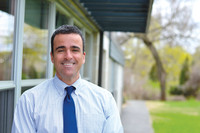Forget financial aid — it's so old school
Gordon School overhauled its tuition model, wiped ‘financial aid’ from the books, and began changing a culture that goes back generations
Gordon School is one month into a groundbreaking, new tuition program, and everything is different. Except, it isn’t. Except, it really is.
The ‘not so different’ part is the diverse student population in an elite East Providence school with a top tuition price of about $34,000. The ‘different’ part is everything else having to do with tuition — what it’s called, how it’s talked about, what it means and how it defines or classifies students in the school.
It’s one thing to say Gordon School is FIT! — it looks great on a bumper sticker — it’s another to understand what that means.
To begin, FIT stands for Family Individualized Tuition. It’s the new program that went live this month after three years of planning.
As of the 2018-19 school year, none of the 350 Gordon families is receiving financial aid. The entire financial aid structure is gone. Even the terminology is gone. You can’t find “financial aid” on the school website, pamphlets or admissions materials, nor can you find it on the digital portal used by parents to apply to the school. Since Gordon’s longtime software vendor could not create a platform without the words “financial aid,” they went out and found a new vendor to write a custom program.
“Financial aid is not something that’s in our terminology or our reality,” said Tom Cicatiello, the school’s chief financial officer. “We’re not window-dressing here, so we didn’t want to have people pull back the curtain and see the same, old thing.”
The new concept is relatively simple. Instead of charging every family the same tuition, with some paying 100 percent and others paying less based on their level of ‘financial aid,’ every family now has its own tuition. And they all pay 100 percent of it. Some pay a $34,000 tuition. Others pay a $25,000 tuition. Others pay a $12,000 tuition.
The school campus is still the same. The programs and curriculums are the same. Staffing is pretty much the same. Overall, the operating revenue and expense budgets are basically the same. All that’s changed is how they talk about the price of a Gordon education.
A cultural shift
“It’s important to think about what the culture of financial aid does to a school,” said new Head of School Dr. Noni Thomas López. “What does it mean to have this idea floating around that the wealthier families in the school are funding the participation of less affluent families? What does it feel like for the families that are on financial aid? How they feel they belong in the school community, to express concerns and issues? … In schools I’ve been at in the past, families that were on financial aid felt like they couldn’t complain about anything, because they didn’t want to put their aid in jeopardy.”
Ms. Thomas López began this year at the same time as the FIT rollout, after taking over for longtime Head Ralph Wales. She inherited FIT, as well as the school’s reputation as a national leader in diversity initiatives, and just a few months into her tenure, she sees deep connections between FIT and the school’s core beliefs.
“We want to create a community where people feel a sense of true, authentic belonging,” she said. “This system really does a lot to create an authentic community.”
She elaborated: “I think culture is not a small thing. I’ve been in rooms where financial aid is talked about as a burden, or it’s eating into a budget, and not being able to do things because we’re committing so much to financial aid. What kind of message does that send to folks that are on financial aid, because the support they’re getting from the school is somehow a burden on the program and the school?”
From ‘needy’ to investors
Mr. Cicatiello said he’s already seen the difference firsthand.
“There are a lot of small things that create the culture around this,” he said. “In the old system, let’s say you received $10,000 of financial aid. Every month, we sent you a bill, and we showed you the full price, and we showed you the aid that you were getting, and every month there was a reminder that you weren’t paying the full price. Today, no more. Now we say, your price is, for example, $20,000. That’s a sizable investment your family is making to this school, and we appreciate that.”
In effect, Gordon is abandoning a tuition system that goes back generations, where families demonstrate “need” in order to get “aid.” Said Ms. Thomas López, “If we’re going to espouse the values that we do, everything we do has to be in alignment with that, particularly if you’re talking about something like socioeconomic circumstances. And that’s something else that is sensitive for independent schools … They rest on their laurels, because they think, ‘well, we have financial aid,’ but they don’t stop to think about how that impacts families.
“Every practice here matters, like the fact that when we’re in our finance meetings, we’re not talking about kids that are on financial aid. It’s important in terms of, when we walk out, how we view our families … Some schools may dismiss this as, ‘it’s the same thing with new wrapping on it.’ It’s a game-changer. This is what independent schools say they want to be, but if they’re not willing to look at how they manage and talk about their families, they’re not going to make the progress they say they want.”
Mr. Cicatiello said he sees benefits on a daily basis. “To be able to sit down and say, ‘your family’s investment in Gordon is this, and here’s why’ … it puts everybody at the same table, at the same level, as opposed to sitting down and saying, ‘what does your family need to be able to come here?’ ”
A great, unmet ‘need’
According to Mr. Cicatiello, nationwide research shows that the “old” system is not working well. Schools offering traditional financial aid programs only fund about 60 percent of the demonstrated “need” from applicants. In addition, he said, because families had to reapply for financial aid every year, they never knew what their tuition would be year to year.
“We found that families were unable to fully commit to the school, because they never knew what was going to happen the following year. Is this the year where I get the full funding and I’m going to stay, or am I going to have to leave? So there were a lot of things about the old system that were ineffective. It really challenged us to rethink, to ask, ‘if you could start over, what would you do?’ ”
Mr. Cicatiello lived in the financial aid system for 21 years, since beginning at Gordon. In that time, he’s seen a major shift in the financial portfolios of Gordon applicants.
“When I first got here, there were many more families paying for tuition through intergenerational wealth, or through trust funds, or through family support. Whereas today, partly because of our desire to diversify the student body, and partly because of changes in the country and the state, people are investing in education out of their household budgets. It’s pretty much off of their W2 … So we said, ‘what can we do about it?’ ”
FIT for three years
Furthermore, he said, because family budgets don’t change very frequently, Gordon has chosen to create more stability. They tell families their FIT price for three years. And the families have to go through the process of paperwork and documentation only once every three years.
“It’s really a game-changer for families,” Mr. Cicatiello said.
Skeptics have challenged the Gordon model as simply window-dressing on the old system, or worse. Said Ms. Thomas López, “I think there were questions about Gordon, whether we were taking this step to get that upper end, up higher.”
It’s not. The top tuition of $34,000 is about 2 percent higher than it was last year.
Ms. Thomas López argues that the new system has made Gordon more transparent in some ways.
“When families in the traditional system get their financial aid model, some of them know that they can make a phone call and mess around with that number. There are other families, you can guess which ones, who don’t have the social capital, who don’t even know they can do that. The fact that we can hold our heads high, and everyone can know that’s their price, and there’s nobody making secret deals in a room with the head of school, is important,” Ms. Thomas López said.
The conversations are also shifting inside the faculty as well, she said.
“The onus is on us to demonstrate the value of a Gordon education. So when we’re with a family who’s feeling like the cost is too much, we’re not going into a dark negotiation where we’re talking about dollars. We talk about the program, and let’s talk about your child, and let’s talk about why this is a great match … So it’s changed things for us, because we’re not going to negotiate on the dollars. We we have to make sure the program is top-notch.”
A much different application
Mr. Cicatiello said the experience for perspective families is vastly different than it used to be. “In the old days, you inquired in September, we had you come to an open house in November, you brought your child for a visit, we got you to fall in love with the school, maybe you had a ‘come and play’ date in January, we accepted you in February, and we told you your price in March,” he said. “That’s a long way to go. Now, you complete the financial part of the application, and after your visit, we give you your FIT price. So that FIT price now is in your hand right after your visit. You can then decide if you want to continue with the process, and you’re certainly more able to fully invest in the process.”
So everything changed at Gordon this year. But then again, it didn’t.
“Gordon School wouldn’t be Gordon School if there were 350 students here all paying $34,000,” Mr. Cicatiello said. “That’s not our program. We know that in order to have the program we want, we need a diverse student population, and that includes a diverse socioeconomic student population … In the first year, we’ve enrolled a student body just as diverse as it was before.”
“This program is in direct alignment with our values,” Ms. Thomas López said.









